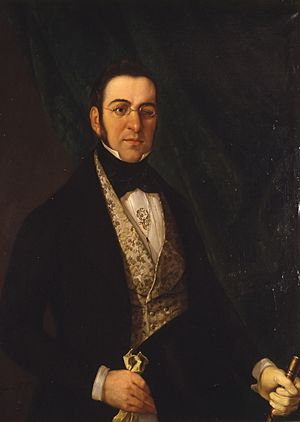Manuel Bretón de los Herreros facts for kids
Quick facts for kids
The Most Excellent
Manuel Bretón de los Herreros
|
|
|---|---|
 |
|
| Born | 19 December 1796 Quel, Spain
|
| Died | 8 November 1873 (aged 76) Madrid, Spain
|
| Seat B of the Real Academia Española | |
| In office 1840 – 8 November 1873 |
|
| Preceded by | Eugenio de Guzmán |
| Succeeded by | Eduardo Saavedra |
Manuel Bretón de los Herreros (born December 19, 1796 – died November 8, 1873) was a famous Spanish writer who created plays for the theater.
Contents
Biography
Manuel Bretón de los Herreros was born in Quel, a town in La Rioja, Spain. He went to school in Madrid.
When he was 15, he joined the army in 1812. He fought against the French in areas like Valencia and Catalonia. He left the army in 1822 with the rank of corporal.
After leaving the army, he worked for the government for a short time. He then decided to make a living by writing plays for the stage.
His first play, Á la vejez viruelas, was shown in 1824. It was a big success and showed he was a talented new writer. Manuel wrote many plays very quickly. Between 1824 and 1828, he wrote 39 plays. Some were completely new, while others were his versions of older, classic works.
In 1831, he translated a work by the ancient poet Tibullus. This made people think he was a great scholar. Because of this, he got a job as a sub-librarian at the national library. However, his true passion was writing for the theater.
Most of his plays were very popular. One time, in 1840, he faced a challenge. The government had become more conservative. In his play La Ponchada, he made fun of the National Guard. This caused him to lose his job at the national library. For a short time, he was not very popular and even thought about moving to America. But soon, things got better, and he became a leading playwright again.
He later became the secretary of the Spanish Academy. Manuel Bretón de los Herreros wrote about 360 original plays. He passed away in Madrid.
Legacy
Manuel Bretón de los Herreros is considered one of the best Spanish playwrights of the 1800s. People remember him for his funny plays and how well he created interesting characters. He was also very skilled with words and poetry.
Some of his plays, like Marcela, o ¿a cuál de los tres? (1831), Muérete y verás! (1837), and La Escuela del matrimonio (1852), are still performed today. They are likely to remain popular for a long time.
The Theatre of Bretón de los Herreros in Logroño is named after him, honoring his contributions to Spanish theater.
Selected works
- A la vejez, viruelas (1817) (In Old Age, Chickenpox)
- Los dos sobrinos o la escuela de los parientes (1825)
- A Madrid me vuelvo (1828)
- El ensayo (1828)
- El rival de sí mismo (1828)
- El ingenuo (1828)
- El templo de Himeneo (1829)
- Achaques a los vicios (1830)
- La sorpresa (1830)
- La falsa ilustración (1830)
- Marcela o ¿a cuál de los tres? (1831)
- Elena (1834)
- Todo es farsa en este mundo (1835)
- Me voy de Madrid (1836)
- La redacción de un periódico (1836)
- Muérete, ¡y verás! (1837)
- Don Fernando el Emplazado (1837)
- Vellido Dolfos (1839)
- El pelo de la dehesa (1840)
- La Ponchada (1840)
- Don Frutos en Belchite (1845)
- El valor de la mujer (1852)
- La escuela del matrimonio (1852)
- La niña del mostrador (1854)
- Al pie de la letra (1855)
- El abogado de pobres (1866)
- Los sentidos corporales (1867)
See also
 In Spanish: Manuel Bretón de los Herreros para niños
In Spanish: Manuel Bretón de los Herreros para niños

